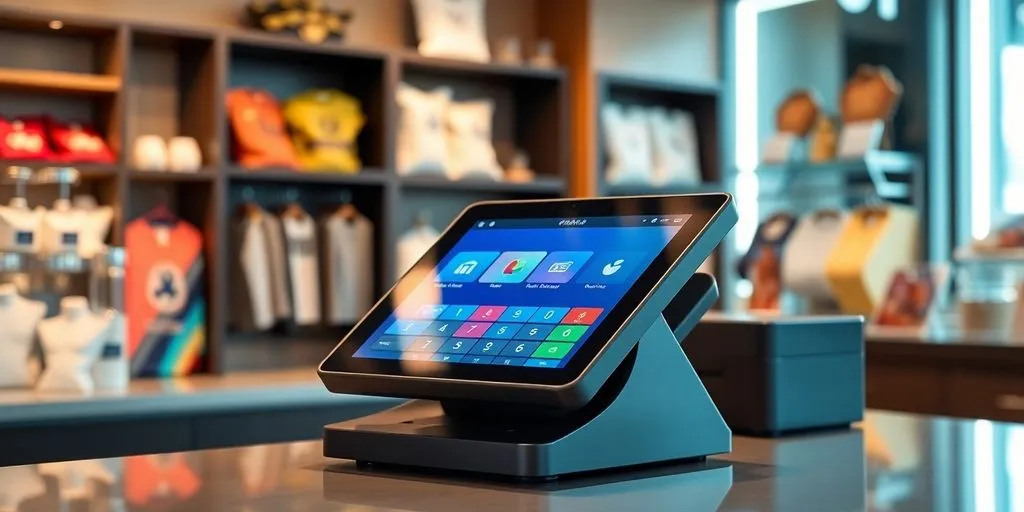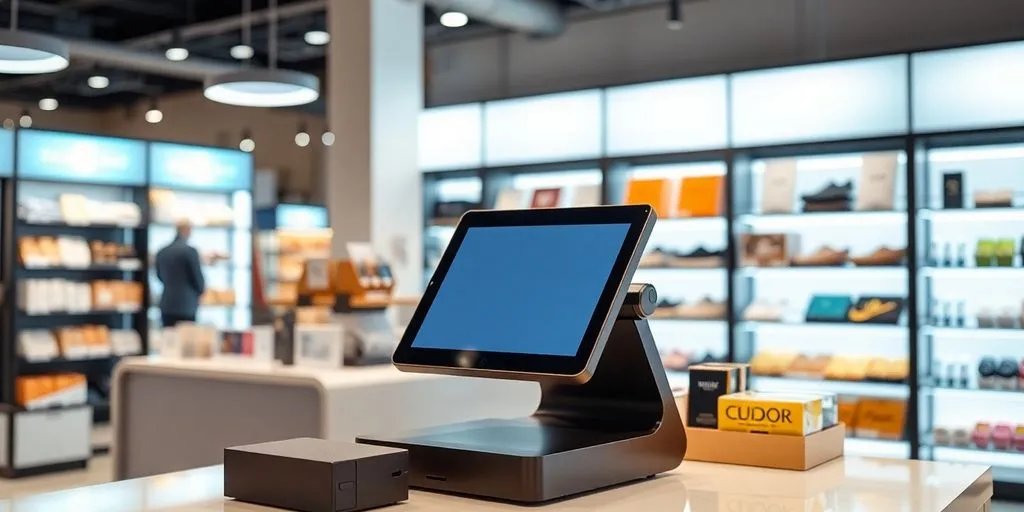Optimizing Sales: How to Choose the Right POS Platform for Your Business
October 2, 2024

In today's retail environment, selecting the right Point of Sale (POS) platform is essential for enhancing customer interactions, improving business workflows, and increasing profits. This article will guide you through the key aspects of choosing a POS system that fits your business needs and helps you thrive.
Key Takeaways on Choosing the Right POS System
- Importance of POS Systems: A Point of Sale (POS) system is essential for managing transactions, enhancing customer experience, and streamlining business operations.
- Key Features: Look for inventory management, sales reporting, customer relationship management, and diverse payment processing options in a POS system.
- Evaluation Process: Assess business needs, compare pricing models, read user reviews, and request demos to choose the right POS platform.
- Integrations: Ensure the POS system integrates with accounting software, CRM systems, and e-commerce platforms for seamless operations.
- Training Staff: Conduct initial training sessions and provide ongoing support to empower employees to use the POS system effectively.
- Maximizing Efficiency: Regular maintenance, monitoring performance metrics, and exploring add-ons can optimize the POS platform.
- Future-Proofing: Consider scalability, adapt to technological advances, and plan for long-term growth to ensure sustained success.
Register Your LLC
Company Registration
START NOWUnderstanding the Importance of a POS Platform for Your Business
A point-of-sale (POS) platform is essential for any business looking to thrive in today’s market. It not only helps in managing transactions but also plays a crucial role in enhancing customer satisfaction and improving overall operations.
Enhancing Customer Experience
- A modern POS system allows businesses to accept various payment methods, making it easier for customers to complete their purchases.
- It can provide personalized discounts and offers, which can lead to increased customer loyalty.
- By streamlining the checkout process, businesses can reduce wait times, leading to happier customers.
Streamlining Business Operations
- POS systems help in tracking inventory in real-time, ensuring that businesses never run out of popular items.
- They can generate detailed sales reports, giving insights into what products are performing well and which are not.
- With integrated customer data, businesses can better understand consumer behavior and preferences, allowing for more informed decision-making.
Boosting Sales and Revenue
- By simplifying the payment process, businesses can increase their sales volume.
- A POS system can help identify trends and patterns in sales, enabling businesses to adjust their strategies accordingly.
- Investing in a robust POS platform can lead to higher efficiency and productivity, ultimately boosting revenue.
A well-chosen POS platform can transform your business operations, making them more efficient and customer-friendly.
In summary, a POS platform is not just a tool for processing payments; it is a vital component that can enhance customer experience, streamline operations, and significantly boost sales and revenue.
Key Features to Look for in a POS Platform

Choosing the right POS platform is crucial for your business's success. Here are some key features to consider:
Inventory Management
A good POS system should have strong inventory management capabilities. This includes:
- Tracking stock levels in real-time
- Sending alerts for low inventory
- Easy updates for product information
Sales Reporting and Analytics
Effective sales reporting helps you understand your business better. Look for:
- Detailed sales reports with charts and graphs
- A user-friendly dashboard for real-time data
- Insights into customer buying patterns
Customer Relationship Management
A POS system should help you manage customer relationships. Key features include:
- Storing customer information
- Tracking purchase history
- Sending personalized promotions
Payment Processing Options
Make sure your POS platform supports various payment methods. This includes:
- Credit and debit cards
- Mobile payments
- Contactless payments
Remember: The right POS system can significantly enhance your business operations and customer satisfaction.
Summary Table of Key Features
How to Evaluate Different POS Platforms
Choosing the right POS platform is crucial for your business. Here are some steps to help you make the best choice:
Assessing Your Business Needs
- Identify your core requirements: What features do you need? Consider aspects like inventory management, customer tracking, and payment processing.
- Think about your business type: A retail store may need different features than a food truck.
- Consider your budget: Determine how much you can spend on a POS system.
Comparing Pricing Models
- Look for transparent pricing: Ensure you understand all costs involved, including transaction fees.
- Evaluate different tiers: Many systems offer various pricing levels based on features and usage.
- Check for hidden fees: Be aware of any additional costs that may arise.
Reading User Reviews and Testimonials
- Seek feedback from other businesses: Ask for references from companies using the same POS system.
- Look for common themes: Are there recurring praises or complaints?
- Consider the source: Ensure reviews are from credible users who have experience with the system.
Requesting Demos and Trials
- Take advantage of free trials: Most providers offer demos to test the system.
- Make notes during the demo: Pay attention to what works well and what doesn’t.
- Communicate your findings: Share any concerns with the provider for clarification.
Evaluating different POS platforms is essential for ensuring you choose a system that meets your business needs. Understanding your requirements and comparing options will lead to better decisions.
By following these steps, you can confidently select a POS platform that aligns with your business goals and enhances your operations. Remember, the right choice can significantly impact your sales and customer satisfaction!
Integrating Your POS Platform with Other Business Systems

Integrating your POS system with other business tools is essential for streamlining operations and enhancing efficiency. Here are some key integrations to consider:
Accounting Software Integration
- Connect your POS with accounting software to automate financial tracking.
- This helps in reducing manual entry errors and saves time.
- Popular options include QuickBooks and Xero.
CRM System Integration
- Integrate with Customer Relationship Management (CRM) systems to manage customer data effectively.
- This allows for personalized marketing and improved customer service.
- Examples include Salesforce and HubSpot.
E-commerce Platform Integration
- If you sell online, linking your POS with your e-commerce platform is crucial.
- This ensures that inventory levels are updated in real-time across all sales channels.
- Consider platforms like Shopify or WooCommerce.
By ensuring these integrations, you can optimize your business and provide a seamless experience for your customers.
Integrating your POS system with other tools not only saves time but also enhances the overall efficiency of your business operations.
Summary Table of Key Integrations
Training and Supporting Your Staff on the POS Platform
Conducting Initial Training Sessions
To get your team up to speed with the new POS system, initial training sessions are essential. Here are some steps to follow:
- Schedule training sessions soon after the system is installed.
- Use hands-on demonstrations to show how to navigate the system.
- Provide training materials that staff can refer to later.
Providing Ongoing Support
Even after the initial training, ongoing support is crucial. Consider these options:
- Set up a help desk for quick questions.
- Encourage staff to share tips and tricks with each other.
- Regularly update training materials as the system evolves.
Utilizing Vendor Resources
Many POS vendors offer resources to help train your staff. Make sure to:
- Take advantage of online tutorials and webinars.
- Request additional training sessions from the vendor if needed.
- Explore any user manuals or guides provided by the vendor.
Investing in effective POS training for your employees can empower them to use the system efficiently, leading to better customer service and increased sales.
Optimizing Your POS Platform for Maximum Efficiency
To get the most out of your POS system, consider these key strategies:
Regular Maintenance and Updates
Keeping your POS system updated is essential. Regular updates help prevent issues and ensure your system runs smoothly. Here are some tips:
- Schedule updates during off-peak hours.
- Check for software patches regularly.
- Ensure all hardware is functioning properly.
Monitoring Performance Metrics
Tracking how well your POS system performs can help you make better decisions. Use the built-in analytics tools to:
- Review sales data daily.
- Identify peak sales times.
- Monitor inventory levels to avoid stockouts.
Exploring Add-ons and Extensions
Many POS systems offer additional features that can enhance your operations. Consider:
- Integrating with accounting software for easier financial management.
- Adding customer relationship management (CRM) tools to improve customer service.
- Utilizing apps that streamline order processing, especially in restaurants, to efficiently manage order taking and payment processing.
By optimizing your POS platform, you can enhance efficiency and improve customer satisfaction, leading to increased sales and revenue.
Future-Proofing Your POS Platform
Scalability Considerations
To ensure your POS system can grow with your business, consider the following:
- Flexibility: Can you easily add new features as your needs change?
- Upgrade Costs: What are the costs involved in upgrading the system?
- Long-Term Needs: Will you need to switch systems in the future?
Adapting to Technological Advances
Staying updated with technology is crucial. Here are some ways to adapt:
- Regular Updates: Ensure your POS software receives updates to keep up with new features and security.
- Integration: Look for systems that can integrate with new technologies, like mobile payments or e-commerce platforms.
- User Feedback: Regularly gather feedback from staff to identify areas for improvement.
Planning for Long-Term Growth
Planning ahead can save you time and money. Consider these steps:
- Market Trends: Stay informed about industry trends that may affect your business.
- Customer Needs: Regularly assess what your customers want and how your POS can meet those needs.
- Financial Planning: Budget for future upgrades and expansions to avoid unexpected costs.
Future-proofing your POS system is essential for sustained success. By considering scalability, adapting to technology, and planning for growth, you can ensure your business remains competitive in a changing market.
Conclusion
Choosing the right POS system is a key step for any business looking to grow. By following the tips outlined in this article, you can make a smart choice that fits your needs. Remember to think about what features are most important for your business, like payment options and inventory management. Don't forget to check reviews and ask other business owners for their opinions. Testing out a system with a demo can also help you see if it’s the right fit. With the right POS system, you can improve sales, understand your customers better, and make your business run more smoothly.
Frequently Asked Questions
What is a POS system and why is it important?
A POS system, or Point of Sale system, is where sales happen in a store. It helps businesses manage sales, track inventory, and understand customer preferences.
What features should I look for in a POS system?
Key features to look for include inventory management, sales tracking, customer management, and various payment options.
How can I tell which POS system is right for my business?
Start by assessing your business needs, comparing prices, reading reviews, and asking for demos from different providers.
Can I integrate my POS system with other business tools?
Yes, many POS systems can connect with accounting software, customer relationship management (CRM) tools, and online stores.
How should I train my staff on the new POS system?
Hold initial training sessions and provide ongoing support to help your staff become comfortable with the system.
What can I do to ensure my POS system stays efficient?
Regularly update the system, monitor performance metrics, and explore add-ons or extensions that could improve its functionality.

